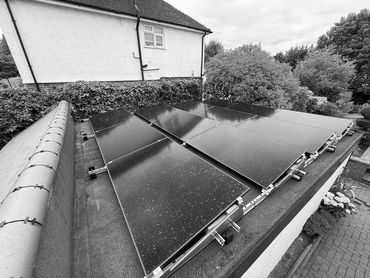Recent Projects
Recent Projects



Powering Progress in Bromley- 6.9kW System
Our most recent Bromley project showcases a sleek and efficient 6.9kW flat roof solar system, featuring 16 all-black premium panels for a clean, modern aesthetic. At the heart of this setup are cutting-edge components: a GivEnergy G3 6kW String Inverter and two GivEnergy 6kW All-in-One AC Coupled Systems, expertly converting solar energy into reliable mains (AC) power. Designed for high performance, this system is projected to generate an impressive 6,735 kWh annually—delivering long-term energy savings and a significant step toward sustainability.
High-Efficiency 6.8kW Solar System in Kent
Our latest residential installation in Bromley showcases a 6.8kW flat roof solar system, designed for maximum performance and a sleek, modern look. The system features 16 × 425W all-black premium panels, offering both efficiency and a visually clean finish.
Powering the system are two advanced components:
- 1 × Growatt MIN 6000 TL-X single-phase inverter, equipped with Arc Fault Protection (including DC protection)
- 1 × GivEnergy 6kW All-in-One AC Coupled System
With 13.5 kWh of battery storage, this setup is built not only to generate but also to store solar energy efficiently, increasing self-consumption and resilience.
Engineered for durability and performance, the system is projected to produce an impressive 7,514 kWh annually, helping the homeowner cut energy costs and move toward greater sustainability.
Customer Feedback- "A very good company to deal with from start to finish. The service, standards and finished product was as promised and at a great value. The solar panels look great and my electric bill even better."

Farleigh- 17kW Solar PV & Battery
The Farleigh project consists of a 17kw flat roof system. The system includes 30kw battery storage, with full home back up during power cuts. The residents also chose a EV Charger installation that supports diverting solar surplus energy - it does not require grid charging!
Project-Bromley-3.6kW Solar PV & Battery Storage
Our team recently completed a 3.6 kW solar PV project in the Bromley area, which included 13kW of battery storage using a Growatt Hybrid Inverter, and an Easee EV charger with the ability to use surplus energy.
To ensure safe access, we provided scaffolding during the installation process. We installed two new consumer units - one for highload circuits and another for EPS circuits. The EPS consumer unit uses grid supply and in case of a power cut, we have installed an auto changeover switch, which allows the battery storage to supply the EPS consumer unit using stored energy. Additionally, the EV charger utilises any surplus energy from the solar PV system.
We also installed the provision for a dedicated supply for the hot water immersion. If there is any surplus energy from the solar PV system, it will be used to heat the water. We take pride in our attention to detail and ensuring that all of our projects meet the highest standards of quality and efficiency.

Chigwell- 5kW Solar PV & Battery Storage
Bickley- 8.3kW Solar PV & battery Storage
Bickley- 8.3kW Solar PV & battery Storage

Bickley- 8.3kW Solar PV & battery Storage
Bickley- 8.3kW Solar PV & battery Storage
Bickley- 8.3kW Solar PV & battery Storage

Chislehurst - 5kW Solar PV & Battery Storage
Chislehurst - 5kW Solar PV & Battery Storage
Chislehurst - 5kW Solar PV & Battery Storage

Petts Wood- 5kW Solar PV & Battery Storage
Chislehurst - 5kW Solar PV & Battery Storage
Chislehurst - 5kW Solar PV & Battery Storage

Photo Gallery
Frequently Asked Questions
Please reach us at info@wayrehouse.co.uk if you cannot find an answer to your question.
While a south-facing roof is ideal for solar panels, it is not always necessary. East-facing and west-facing roofs can still generate a significant amount of solar energy, although they may not be as efficient as a south-facing roof. The direction and angle of the roof, as well as shading from trees or other buildings, can also affect the performance of solar panels. A qualified solar panel installer can assess your roof and provide recommendations based on its specific characteristics.
Solar Panels can be fitted to your roof. Generally an 8-panel Solar PV system would be one of the smallest we would recommend and this could easily fit on the roof of an average 3-bed semi.
No, solar panels can still generate electricity even on cloudy or overcast days. While sunshine does improve their performance, solar panels can still work on days with low levels of sunlight. In fact, solar panels in cooler temperatures actually perform better than those in very hot temperatures. It's important to note, however, that the amount of electricity generated by your solar panels will be reduced on days with less sunlight.
Solar panels are designed to be durable and long-lasting. Most manufacturers offer warranties that guarantee that the panels will produce a certain amount of power for 25 years or more. However, the actual lifespan of solar panels can vary depending on a number of factors, including the quality of the panels, the installation process, and the conditions in which they are used.
In general, high-quality solar panels that are installed properly and maintained regularly can last for 25 to 30 years or more. Some panels may continue to produce electricity at a reduced level even after this period, but it is usually not economical to keep them in operation.
It is important to note that the lifespan of solar panels is not the same as the lifespan of the entire solar system. Other components of the system, such as inverters and batteries, may need to be replaced sooner than the panels themselves. It is also important to have regular inspections and maintenance of the system to ensure optimal performance and longevity.







